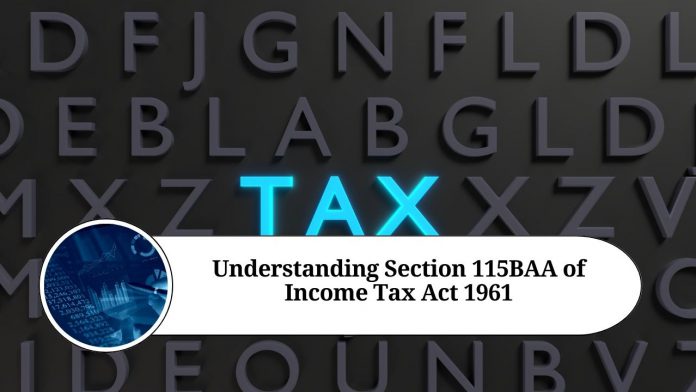Introduction:
The Income Tax Act, 1961 provides various provisions to help taxpayers reduce their tax liabilities. Section 115BAA is one such provision that was introduced in the Union Budget of 2019. In this blog, we will discuss section 115BAA in detail.
What is Section 115BAA?
Section 115BAA is a provision in the Income Tax Act, 1961 that allows domestic companies to opt for a lower tax rate of 22% if they do not claim certain specified deductions or exemptions.
Eligibility Criteria:
To be eligible for the lower tax rate under section 115BAA, the company must meet the following conditions:
The company must be a domestic company as defined under the Income Tax Act, 1961.
The company must not claim any deduction or exemption under certain specified sections of the Income Tax Act, including sections 10AA, 32, 32AD, 33AB, 33ABA, and 35.
The company must not have any brought forward losses or unabsorbed depreciation from the previous years.
Benefits of Section 115BAA:
The key benefit of section 115BAA is that eligible companies can enjoy a lower tax rate of 22% as compared to the previous tax rate of 30%. This lower tax rate can help companies reduce their tax liabilities and improve their profitability.
However, it is important to note that once a company opts for the lower tax rate under section 115BAA, it cannot claim any of the deductions or exemptions that it has given up. Therefore, companies should carefully consider their options and evaluate the pros and cons of opting for this provision.
Procedure for Opting for Section 115BAA:
To opt for the lower tax rate under section 115BAA, eligible companies must file Form 10-IC before the due date of filing the income tax return. Once the option is exercised, it cannot be withdrawn for subsequent years.
Some of the key points to consider when evaluating the impact of opting for section 115BAA include:
- Impact on Tax Liability: The most obvious benefit of section 115BAA is the reduction in tax liability. However, companies must evaluate whether the reduction in tax liability is significant enough to outweigh the benefits of the deductions and exemptions they would give up.
- Impact on Profitability: Opting for section 115BAA can improve a company’s profitability by reducing its tax liability. However, companies must also consider the impact of giving up deductions and exemptions on their overall profitability. For example, if a company gives up deductions related to research and development, it may impact its ability to innovate and grow.
- Impact on Compliance: Companies must also consider the impact of opting for section 115BAA on their compliance requirements. Giving up deductions and exemptions can simplify compliance requirements since companies no longer need to keep track of them. However, companies must still comply with the other provisions of the Income Tax Act, 1961.
- Long-Term Impact: Opting for section 115BAA can have long-term impacts on a company’s tax liability and profitability. Therefore, companies must carefully evaluate the long-term impact of giving up deductions and exemptions before opting for this provision.
Conclusion:
In conclusion, section 115BAA of the Income Tax Act, 1961 provides eligible domestic companies with the option to opt for a lower tax rate of 22% by giving up certain deductions and exemptions. This provision can help companies reduce their tax liabilities and improve their profitability. However, companies must carefully evaluate their options and consider the impact of giving up deductions and exemptions before opting for this provision.
Read more useful content:
- section 145 of income tax act
- section 10e of income tax act
- section 9 of the income tax act
- section 94b of income tax act
- section 206aa of income tax act
Frequently Asked Questions (FAQs)
Who is eligible for the lower tax rate under section 115BAA?
Ans: Domestic companies as defined under the Income Tax Act, 1961 are eligible for the lower tax rate under section 115BAA.
What is the tax rate under section 115BAA?
Ans: The tax rate under section 115BAA is 22%.
Can companies claiming deductions and exemptions under the specified sections opt for section 115BAA?
Ans: No, companies claiming deductions and exemptions under the specified sections cannot opt for section 115BAA.
What are the specified sections under which companies cannot claim deductions and exemptions?
Ans: The specified sections under which companies cannot claim deductions and exemptions include sections 10AA, 32, 32AD, 33AB, 33ABA, and 35.
Can companies opt for section 115BAA for a particular year and not opt for it in subsequent years?
Ans: No, once a company opts for section 115BAA, it cannot withdraw the option for subsequent years.
Can companies claim deductions and exemptions under other sections of the Income Tax Act, 1961 after opting for section 115BAA?
Ans: Yes, companies can claim deductions and exemptions under other sections of the Income Tax Act, 1961 after opting for section 115BAA.
Is it mandatory for eligible companies to opt for section 115BAA?
Ans: No, it is not mandatory for eligible companies to opt for section 115BAA. They can continue to pay tax at the normal tax rates.
What is Form 10-IC?
Ans: Form 10-IC is the form that eligible companies must file to opt for the lower tax rate under section 115BAA.
Can companies with brought forward losses or unabsorbed depreciation from previous years opt for section 115BAA?
Ans: No, companies with brought forward losses or unabsorbed depreciation from previous years cannot opt for section 115BAA.
Can companies opt for section 115BAA for some of their income and pay tax at normal rates for other income?
Ans: No, companies must opt for section 115BAA for their entire income if they choose to opt for this provision.




















